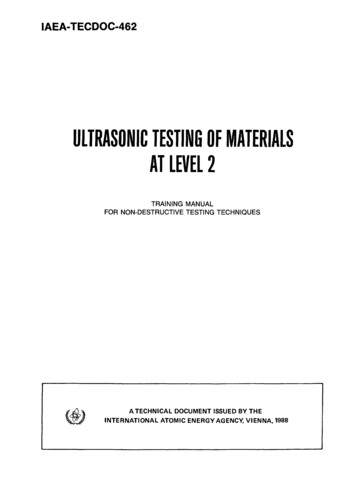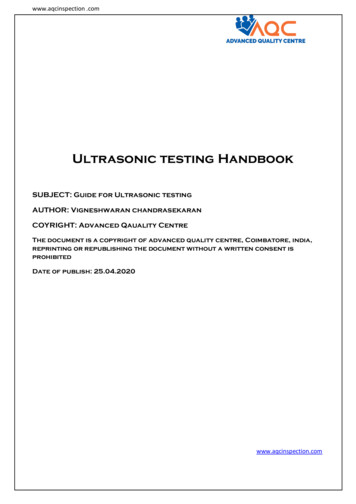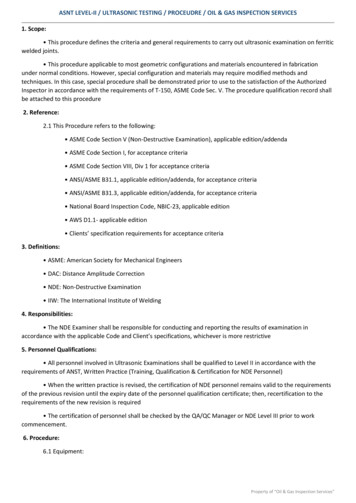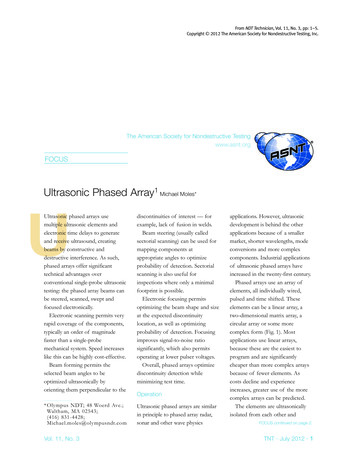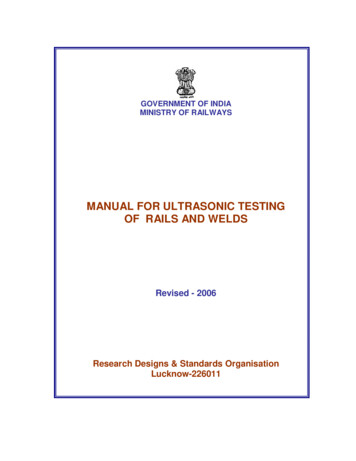
Transcription
GOVERNMENT OF INDIAMINISTRY OF RAILWAYSMANUAL FOR ULTRASONIC TESTINGOF RAILS AND WELDSRevised - 2006Research Designs & Standards OrganisationLucknow-226011
PREAMBLEUltrasonic testing of rails was introduced over Indian Railways during early 60s.From a humble beginning, this technique has graduated itself to an extent that today it is oneof the most powerful tools of preventive maintenance of the permanent way. During the last40 years of its existence, a large number of testing procedures, specifications, guidelines andcriteria have been issued from time to time based on the experience gained. In the meantime,the scope of testing has been extended to Alumino Thermic (AT), Flash Butt (FB), GasPressure (GP) welded joint, SEJs and Points and Crossings.The advent of fracture mechanics concept coupled with state of the art steel makingtechnology has thrown open a new dimension in the periodicity of ultrasonic examination.The rate of crack propagation and fracture toughness characteristics of rails can beexperimentally found which determine the critical crack size.Based on the above knowledge and experience, it was considered necessary toassimilate the entire information on ultrasonic examination of rails and present in the formof a manual so as to guide the ultrasonic personnel in testing, interpretation and decisionmaking. Accordingly, the first edition of the USFD Manual was prepared and issued during1998. Subsequently, a revision was imminent in view of the experience and maintenancepractices. This revised edition is therefore prepared incorporating all the amendments andrevisions. The provisions made are mandatory for all ultrasonic personnel and supersedeall previous instructions in case they happen to be contradictory to the instructions containedin this manual. This revised version of the manual incorporates Correction Slip No. 1 to 17to USFD Manual (1998).It is also mentioned here that this manual has been exclusively prepared for manualultrasonic examination of rails and welds and does not cover test procedures for selfPropelled Ultrasonic Rail Testing (SPURT) Car.ii
LIST OF CHAPTERSS.No.DescriptionPage No.1.Rail defects and their codification12.Ultrasonic testing of rails at manufacturer’s works83.Ultrasonic rail testing equipment and accessories94.Calibration, Sensitivity setting, Maintenance of machines and functions ofprobes115.Procedure to be followed by USFD operators for undertaking ultrasonictesting of rails166.Need based concept in periodic USFD testing of rails and welds187.Limitations of ultrasonic flaw detection of rails238.Procedure for ultrasonic testing of Alumino-thermic welded joints269.Ultrasonic testing of flash butt and gas pressure welded joints3110.Ultrasonic testing of rails required for fabrication of points & crossings3511.Ultrasonic testing technique of worn out point and splice rail prior toreconditioning by welding and switch expansion joint3712.Ultrasonic testing of rails by SPURT Car4113.Reporting and analysis of Rail/Weld failure45iii
LIST OF ANNEXURESAnnexure No.DescriptionPage No.Annexure ISketch showing details of standard test piece for ultrasonic testing46Annexure IIClassification of Rail/Weld defects for Need Based concept of USFD47Annexure IIIProforma for reporting Rail/ Weld replacement or removal ondetection by USFD49Annexure IV Details required for Rail/Weld failure analysis53Annexure V57Check list of ultrasonic testing of Rails/Welds)Annexure VI Master register for defects detected and Rail fractures59Annexure VII Master register for defects detected and Weld fractures60Annexure VIII Inspection of rail tester and work of PWI/ (USFD)61iv
LIST OF FIGURESDescriptionArrangements of probes for testing of new rails in steel plantsArea covered by Normal (00 )probeArea covered by 700 probeArea covered by 370 probe ( for bolt hole cracks)Area covered by 700, 2MHz probe (Testing for AT weld flange)Area covered by Gauge face corner detection equipmentStandard rail with artificial flaws(Need Based Criteria)Standard rail with artificial flaws for checking of performance of railtesters.Fig. 5Rail without flaw (00) probeFig. 6Longitudinal horizontal split in head region (type 112, 212, 00 probe)Fig. 7Longitudinal Horizontal split in head web junction (type 1321-2321, 00Probe)Fig. 8Vertical longitudinal split in head (type 113, 213, 00 probe)Fig. 9Side probing of rail head , without flawFig.10Vertical Longitudinal split in head (00 side probing)Fig.11Vertical longitudinal split in web (type 133, 233, 00 probe)Fig.12Side probing of rail web without defectFig.13Vertical longitudinal split in the web 00 side probing.Fig.14Segregation (00 probe )Fig.15Bolt hole without crack (00 probe ).Fig.16Bolt hole with crack (type 135, 235, 00 probe ).Fig.17Bolt hole without crack (370 probe).Fig.18Bolt hole with crack in upper half (370 probe, type 135, 235).Fig.19 Transverse defect (type 111, 211, 700 2MHz, forward probe).Fig.20Transverse defect (type 111, 211, 700 2MHz, backward probe).Fig.21. Undetectable star cracks (00 probe)Fig.22Undetectable star cracks (370 probe).Fig.23(a) Standard AT welded rail piece with artificial flaws for sensitivity setting ofultrasonic equipment to examine AT welds.Fig.23(b) Standard AT welded rail piece with artificial flaws for sensitivity setting ofultrasonic equipment to examine 75mm wide gap AT welds.Fig.24(a) Sketch showing the location of flange of rail for ultrasonic testing with 70 0,2MHz angle probe.Fig.24(b) Testing of bottom flange of A.T. welds using 700 and 450 Probes.Fig.25Standard AT welding rail test piece(half moon crack)Fig.26Probe positions for testing of half moon crack with 450 probe.Fig.27(a) Position of 450 angle probes and beam path for various flaw locations whenexamining the head of G.P & F.B.welds.Fig.27(b) Position of 700 angle probe and beam path for various flaw locations whenexamining the web and foot of G.P & F.B.weldsFig.28Standard test rail piece for testing before manufacturing of points andcrossings.Fig.29 (a) Testing procedure for points and splice rails for 1 in 12 crossing BG 52 Kg.Fig.29 (b) Standard test piece (SEJ stock rail).Fig.29 (c) Beam direction of angle probes for sensitivity settingFig.30Detail of probes used for testing of rails and welds.Fig.31 to 56 Typical rail defects.Fig.No.Fig. 1Fig. 2AFig. 2BFig. 2CFig. 2DFig. 2EFig. 3Fig. 4vPage 687888990919293949596979899100101102-115
CHAPTER 1RAIL DEFECTS AND THEIR CODIFICATIONRail is the most important and critical component of the permanent way. Most commoncause of rail failure is the fatigue fracture, which is due to imperfections present in the materialor due to crack formation during service. Thus successful performance of rails is based on theirresistance to crack initiation and crack propagation. It is therefore essential to identify andclassify the defects in rails and in turn initiate corrective action. A brief on nature of defects,their causes and classification is presented below.1.1Causes of defects: The origin and development of such cracks is due to:1.1.1 Material defects originating during the manufacturing process such as clusters of nonmetallic inclusions, hydrogen flakes, rolling marks, guide marks etc. which may be present inspite of successful non-destructive tests carried out on the rails duringqualityassuranceexamination.1.1.2 Residual stresses induced during manufacture (cooling, rolling, gas pressing andstraightening).1.1.3 Defects due to incorrect handling e.g. plastic deformation, scoring, denting, etc.1.1.4 Defects associated with faulty welding i.e. gas pores, lack of fusion, inclusions,etc.cracks1.1.5 Dynamic stresses caused by vertical and lateral loads particularly by vehicles withwheel flats or when the vehicle runs over poorly maintained rail joints etc.1.1.6 Excessive thermal stresses due to variation in rail temperature beyond specifiedlimits.1.2Defect location: In order to study the fractures in rail systematically, they may bedivided into the following categories based on their location of occurrence in the raillength:(a)Defects emanating from the rail end or reaching the end of the rail.(b)Defects observed within fish-plated zone.(c)Defects not covered in (a) and (b).1.2.1 Nature of defects in rails(a)Horizontal crack in head: These cracks run usually parallel to the rail table at a depth of10-20 mm and may finally split the material layer. Crushing of the railhead may also beobserved in the vicinity of the crack. Clusters of non-metallic inclusions and abnormalvertical service stresses are the factors responsible for this defect. USFD can easilydetect such flaws.1
(b)Vertical-longitudinal split in head: These cracks run parallel to the longitudinal axis ofthe rail and are caused by presence of non-metallic inclusions, poor maintenance of jointsand high dynamic stresses. It cannot be easily detected in early stages by USFD due totheir unfavourable orientation.(c)Horizontal crack at head web junction: Such flaws may lead to rail head separation.Contributory causes are wheel flats, bad fish-plated joint, inclusions and high residualstresses. USFD is sensitive to such defects and can easily detect them.(d)Horizontal crack at web-foot junction: Such cracks develop both towards head and foot.They are caused by high vertical and lateral dynamic loads, scoring and high residualstresses. USFD can easily detect these flaws.(e)Vertical longitudinal splitting of the web: It is primarily due to heavy accumulation ofnon-metallic inclusions and wheel flats. USFD conducted from rail top can detect it onlyif the defect is severe and in an advanced stage. Vertical longitudinal defects of minornature are not amenable to USFD examination conducted from rail top. Probing fromrailhead sides can detect such defects for which hand probing may be essential.(f)Bolt hole crack: Such cracks often run diagonally and may run towards head or the foot.They result from inadequately maintained joints and unchamfered fish boltholes andstress concentration. USFD (37o probe) can easily detect these cracks. Normal probesprovide indication as diminished back wall echo.(g)Transverse fracture without apparent origin: These fractures occur suddenly, especiallyduring winter and may emanate from microscopic flaws (embedded or on surface) andare generally very difficult to detect by USFD. These minute flaws manifest suddenlyunder severe service conditions or when the fracture toughness values are comparativelylow.(h)Transverse fatigue crack in head: They resemble a kidney in shape in the railhead andUSFD is ideally suited for detecting them. They are generally inclined at the angle of18o-23o and originate at a depth of 15-20 mm below the running surface. Mainlyhydrogen accumulation and non-metallic inclusions cause this defect. These cracks areeasily detected by 70 o probe.(i)Horizontal crack at top and bottom fillet radius: These cracks are caused byaccumulation of non-metallic inclusions and high residual stresses introduced at the timeof rail straightening. These are difficult to be detected by USFD.(j)Vertical longitudinal crack in foot: Such cracks develop from sharp chamfers on thebottom surface of the rail foot. Cracks occurring in this way are the points of origin oftransverse cracks in the foot.(k)Transverse cracks in rail foot: Due to localised overheating during FB welding,structural changes in the bottom surface of the rail material takes place which result in aminor crack. These cracks under the tensile loading give rise to brittle fracture. Suchdefects are not detectable by USFD. Transverse cracks originated from AT welds in therail foot grow as half moon and are detectable by 45o probe.2
1.2.2 Nature of defects in welds: Joining rails by improper welding may introduce a variety ofdefects on the joints as well as in the heat affected zone (HAZ) e.g. lack of fusion, cracks,porosity, slag inclusion, structural variation, etc. The quality of weld depends to a largeextent on the careful execution of the welding operation. USFD testing done by manualrail tester suffers from following deficiencies:(i)Full cross section of weld is not covered by normal USFD examination using manualtester thereby leaving areas in head and foot, which may have flaws.(ii)Micro structural variations in the weldment cause attenuation of ultrasonic energy.Therefore, a separate testing procedure for welds has been developed which is elaboratedin Chapters 8 and 9.1.2.2.1 Defects in Flash Butt Welds(a)Transverse cracks: The origin of these cracks is the imperfection in the weldment suchas lack of fusion, inclusions, etc. Fracture usually occurs from these imperfections,which may be in railhead, web or foot. During the course of its propagation USFDtesting is extremely effective.(b)Horizontal cracks: These cracks develop in the web and propagate both in head andfoot. The principal cause is large tensile residual stresses acting in the vertical direction.1.2.2.2 Defects in Alumino-Thermic (AT) Welds(a)Transverse crack in head and foot: It is caused by inclusions entrapped during welding,which leads to crack initiation on the foot and its growth in the web region causingfracture. Such cracks can be detected by USFD.(b)Horizontal cracks in web: These cracks occur in AT welds in which the ends having boltholes have not been removed. The presence of holes result in unfavorable stressdistribution caused due to non-uniform cooling. USFD can easily detect such flaws.1.3Codification of rail and weld defects: Information regarding the type and nature of railfailures and their service conditions is primarily obtained through personnel responsible formaintenance of permanent way and it is of utmost importance that they are familiar with thevarious types and nature of rail defects and their possible causes to enable them to report the railfailures accurately. With this objective in view, it is necessary to devise a suitable coding systemfor reporting rail failures.1.3.1 UIC has adopted an Alphanumeric system of codification of rail failures. In view ofits international status and the facility afforded for computerized statistical dataanalysis, this system has been adopted by Indian Railways for reporting rail failures.The code for reporting rail failures consists of two parts viz first – Alphabetic,consisting of three code letters and second numeric, consisting of three or four digits.3
1.3.1.1 First part of the code(a)First code letter indicates the type of rail:OX(b)indicatesindicatesPlain railPoint & crossing railSecond code letter which follows the first code letter, indicates the reasons for withdrawof rail. actured railCracked railDefective rail other than F&CThird code letter which follows the second code letter, indicates probable cause of failureor rail. catesDWindicatesindicatesOindicatesCause inherent in rail (attributable to faults in the steelmaking stage and / or its rolling into rails).Fault of rolling stockExcessive corrosionBadly maintained jointOther maintenance conditions (Defects which develop dueTo ineffective maintenance or delayed renewal of rails).DerailmentAssociated with welding defects (through or adjacentWithin 100 mm of a welded joint)Other causes1.3.1.2 Second part of the code Numeric : This part of the code consisting of three or fourdigits indicates the location of the failure in the rail as well as its characteristics :(a)The first digit indicates the location of rail failure (head, web or foot)(b)The second digit indicates:(c)(i)The position in the rail section from which failure has started except where failureis associated with welding.(ii)In case of welding, the second digit indicates the type of welding.The third digit is interpreted in relation to the first two digits of the code viz :(i)(d)If failure is due to internal defect (first digit 4 or second digit 1,3 or 5), it showsthe direction of the crack or fracture.(ii)If failure is due to surface defect (second digit 2 or 5), it indicates the nature ofdefect.(iii)If failure is by damage (first digit 3), it indicates the cause of the damage (detailshave been given in succeeding pages)The fourth digit gives further details.4
1.3.1.3 The summary of codification of rail and weld failures is given as under:(a)First Part – Alphabetic codes1 st letterType of railO-Plain railX-Points &Crossings rail(c)2nd letter3rd letterReason for withdrawalF-FracturedC-CrackedD-Defect other than F&CProbable cause of failureR-Inherent in railS-Fault of rolling stockC-Excessive corrosionJ-Badly maintained uredeveloped later)W-Associated with weldingO-Other causesSecond Part – Numeric codes1st digit2nd digitLocation& Origin/Typecharacteristics Of welding3rd digiti) For internal defects inwelding shows direction:if 2nd digit 1,3,5.1.Withinfishplate limit0- Unknown1.within head1. Transverse2. Horizontal3. Vertical longitudinal2.Otherlocation2. Surface of 5. Diagonal at holerail head8. Diagonal not at hole3. In web5. In footii)For surface defectsit shows nature ofdefects if seconddigit 2,3,5.0. Corrugation1. Short pitch2. Long corner1. Shallow surface defect1.Running surface2. Breaking out2.Guage corner3. Crushing continuous1. Isolated4. Battering local2 .Repeated5. Wheel burns9. Lap, seam, roll mark54th digitFurther details1.2.1.2.3.At rail seatNot at rail seatTop filletBottom filletNot at fillet radius
1 st digit2 nd digitLocation& Origin/TypecharacteristicsOf welding3rd digiti) For internal defectswelding shows direction:if 2nd digit 1,3,5.3.Damagedone01 Brushing or arcing2 Incorrect machiningdrillingorflamecutting4.Associatedwith weldingType ofwelding1. Flash butt2. Thermit3. Electric arcjoint4. Oxy-acytylene joint7.Buildingup8. Tractionbond0Direction of fracture5.Corrosion4th digitFurther details1. Transverse2. Horizontal5. Diagonal at hole8. Diagonal not at hole01.3.1.4 On the basis of the system of classification described in para 1.3.1.2, a list of the failurecode group to be followed is given as under, along with the meaning of the codes.Within fish-platelimits(1)100Elsewhere on 2422512252232123222323233235238(3)Transverse breakage without apparent origin(i.e. sudden fracture)Internal flaw in head, transverse breakage.Internal flaw in head, horizontal crack.Internal flaw in head, vertical longitudinal split.Head, surface, shallow surface defect (flaking)Head, surface, shallow surface defect (line).Head, surface, breaking out running surface(scabbing)Head, surface, breaking out, gauge corner (shelling)Head, surface crushing or batteringHead, surface local batterHead, surface, wheel burn isolatedHead surface, wheel burn repeatedWeb, horizontal cracks, at top fillet radiusWeb, horizontal crack, at bottom fillet radiusWeb, horizontal crack, not at fillet radiusWeb, vertical longitudinal splitting (pipe)Web, cracks at holeWeb, diagonal cracks not at hole.6
Within fish-platelimits(1)13915111512153301302Elsewhere on 1-472481500-(3)Web, lap.Foot, transverse break at rail seat.Foot transverse break starting away from rail seat.Foot vertical longitudinal split (halfmoon crack)Damage to rail by brushing or arcing.Damage to rail by bad machining, drilling or flamecuttingWelding,flashbutt joint, transverse crackWelding, thermit joint, transverse crackWelding, thermit joint, horizontal crack.Welding, electric arc joint, transverse crackWelding oxyacetylene joint transverse crack.Welding, building up transverse cracking of headacross the built up portion.Welding, building up, built up part breaks away.Welding, traction bond welding crack, at weldCorrosion.1.4-Typical rail/weld failure photographs with their codes are given in Figs. 31 to 56.7
CHAPTER 2ULTRASONIC TESTING OF RAILS AT MANUFACTURERS’ WORKSThe defects in rails may be due to manufacturing deficiencies, defects arising duringservice or defects generated due to a combination of manufacturing defects and serviceconditions. The most important source of defects is the manufacturing deficiencies during steelmaking, rolling and subsequent processing.2.1 Testing methods in Steel Plants : Testing in the Steel Plant is carried out with the help ofan on-line ultrasonic testing equipment having multiple probes covering entire cross-section ofthe rail. A typical arrangement of probes is shown in Fig.1.All these probes are 0o (Normal probes) of frequency varying between 2.5 – 4.0 MHz.They detect defects oriented perpendicular to the direction of the beam.2.2 Criteria for acceptance : The criteria of acceptance is as per clause 10 of IRS :T-12-96(specification of flat bottom railway rails). These are reproduced below:10Freedom from defects10.1 The rails shall be of uniform section throughout and shall be free from all detrimentaldefects such as cracks of all kinds, flaws, piping or lack of metal, etc. having an unfavourableeffect on the behaviour of the rail in service.10.2 The absence of harmful internal defects shall be ensured by the continuous on-lineultrasonic examination. This examination shall be carried out for all rails by the manufacturerto the satisfaction of the inspecting agency.10.3 The manufacturer in his offer shall furnish the detailed method of on-line ultrasonictesting of rails to be followed by him. The limits of permissible defects for ultrasonic testing ofrails shall be as follows and the standard test piece shall be as shown in Annexure-I.Head:1.5 mm dia through holeWeb:2.0 mm dia through holeWeb & Foot junction:2.0 mm dia through holeFoot:0.5 mm deep, 12.5 mm long and 1.0 mm wide notch(Inclined at 20o with vertical axis)2.3In case initial testing of rails has not been done in the rail manufacturing plant, the railsshall be tested either at Flash Butt Welding Plant or at site. In no case rail should be laid in trackwithout USFD testing.8
CHAPTER 3ULTRASONIC RAIL TESTING EQUIPMENT AND ACCESSORIES3.0Ultrasonic testing of rails is a specialized activity and the inspectors carrying out theultrasonic testing of rails shall be trained by RDSO, in the techniques of USFD testing. EachZonal Railway shall create adequate no. of Ex-cadre post of inspectors to ensure that entire tracklength in their jurisdiction is ultrasonically tested at the laid down periodicity.3.1On Indian Railways, flaw detection by ultrasonics is carried out with the help of twodifferent types of equipments viz. Single rail tester and double rail tester. The single rail testerhas been utilised on Indian Railways for over 40 years and the double rail tester is of a relativelyrecent origin (developed Ten years back). In addition hand testers of some designs are also beingused. Current list of RDSO approved sources for ultrasonic rail/weld testers with their respectivemodels, is contained in latest version of ‘Masters list of approved venders’ circulated biannually by Quality Assurance (Mechanical) Directorate of RDSO. Procurement of USFDequipments should be done only from the RDSO approved sources.3.1.1 Total Life of USFD machine is approximately 8 years.3.1.2 Maintenance spares be procured along with the machine and should be as per para 4.4pertaining to maintenance spares.3.2Single rail tester : Single rail tester is capable of testing only one of the rails at a timeand is provided with five probes i.e. 0 o , 70 o Forward (F), 70o Backward (B), 37 o Forward (F)and 37 o Backward (B). The normal probe (0o) is utilised for the purpose of detecting horizontaldefects situated in head, web or foot. The 70o probe has been specifically provided for detectingdefects in the rail head, the most typical of which is the transverse fissure or kidney fracture. 37oprobes have been provided to find out defects originating from the bolt hole (star cracks). Theapproximate coverage of the rail section with the help of the above arrangement is indicated inFig.2A,2B. & 2C.The signal received from the defects by any of the above probes is indicated on the cathode raytube (CRT) screen. In order to find out the origin of detection i.e. which probe has picked up thedefect, provision for eliminating the individual probe operation has been made in the equipment.3.3Double Rail tester:3.3.1 The double rail tester is capable of testing both the rails at a time. However, for each railonly three probes have been provided for the present i.e. 0o, 70o Forward and 70oBackward. This equipment, unlike the single rail tester, has multichannel facility i.e. thesignal received from each probe can be instantaneously distinguished without takingrecourse to process of elimination. This equipment has also been provided with athreshold arrangement, LED display and audio alarm in addition to the CRT screen. Thusthere are three modes of defect indication i.e., CRT, audio alarm and LED display.9
3.3.2 The normal probe is provided for detection of horizontal defects and 70 o probes have beenprovided for transverse defects in the head. For detection of bolt hole defects, theequipment works on the principle of backwall drop, which in the event of a bolt holecrack shows reduction in echo-amplitude of the backwall. It is also supported by separateaudio alarm with distinctly different tone and LED display.3.3.3 The introduction of double rail tester has been specifically made for enhancing theproductivity of testing and as well as improving the quality and accuracy of flawdetection. Due to pre-calibrated arrangement, frequent setting of the equipment is notconsidered necessary.3.3.4 Due to frequent misalignment of probes on the fishplated joints and limitations ofdetection of bolt hole cracks having unfavourable orientation and size, it is desirable todeploy double rail testers on LWR/CWR sections.It is desirable to deploy only the ultrasonic machine of the “single rail tester” for testingsections other than LWR/CWR.3.43.4.1Specification of rail testersThe single and double rail testers shall be procured to RDSO specification. Theresponsibility of inspection for these equipment rests with Director General, RDSO.3.5Types of probes:Following types of probes other than mentioned in para 3.2 and3.3 are also in use. Details of probes and their uses are given at Fig. 30.45o probeFor testing Gas Pressure, Flashbutt Welded rail jointsand Half Moon Defect in AT Welds below web footjunction. and SEJ.70o , 2MHz probe(20mm circular or20mm x 20mm square crystal)Flange & Head testing of AT welds700,2MHz(8mm x 8mm)Half Moon defect in AT weldsbelow web foot junction.10
CHAPTER-4CALIBRATION, SENSITIVITY SETTING, MAINTENANCE OF MACHINES ANDFUNCTIONS OF PROBES4.1Rail testing by ultrasonic method shall be carried out by conventional single rail testingtrolley or by double rail tester in which ultrasonic rail testing unit is connected withprobes through a junction box. Details of frequency and number of each type of probesare as under:TypeFrequencyNo. of probesSingle Rail TesterDouble Rail TesterNormal/0o4MHzOneOne each70o2MHzTwo(F B)Two(F B) each37o2MHzTwo(F B)--Water is used as couplant. This is supplied through a water container attached withthe trolley.4.1.1 The procedure laid down for ultrasonic testing of rails is broadly divided in thefollowing steps:a) Visual inspection of Equipments and accessoriesb) Calibration of equipmentc) Sensitivity setting of the equipment and probesd) Checking of the equipment characteristicse) Testing and interpretationa)Visual inspection of Equipments and accessories - Daily checkUltrasonic equipment is to be inspected daily before start of work for proper functionof plug holders, cable etc. In addition battery condition, proper functioning of echocontrol, proper control and smooth movement of control wheel and alignment of theprobe shall be checked by the USFD operator before commencement of the Tests.After checking proper functioning of the aspects mentioned, the instrument shall becalibrated according to the procedure indicated below.b)Calibration of USFD: The ultrasonic rail tester is to be calibrated for 300mm depthrange (longitudinal wave) with the help of a 60x50x50mm block of steel to grade 45C8 of IS:1875 – 1992.Procedure of calibration(i)Switch on normal probe(ii)Adjust the on set of the surface echo from the perspex of normal probe to zero byusing horizontal shift control /delay control, provided in theelectronic unit.(iii)Place the calibration block below normal probe using water as couplant.(iv)Adjust the range by H-shift/Delay and range control simultaneously so thatfollowing signals appear on the screen.(v)The location of signals for 300mm for machines having 5/10 main scaledivisions on horizontal scale has been indicated below:11
On set of the surface echo from the perspex at 0 main scale div.60mm Signal at 1/2 main scale Horiz.Div.120mm Signal at 2/4 main scale Horiz Div.180mm Signal at 3/6 main scale Horiz Div.240mm Signal at 4/8 main scale Horiz Div.300mm Signal at 5/10 main scale Horiz Div.The equipment is now calibrated for 60/30mm of steel per main scale horizontaldiv. for longitudinal wave.c)Sensitivity setting of the equipment and probes– Weekly checkThe sensitivity of the USFD equipment shall be set up once in a week with thehelp of standard rail pieces as mentioned below:Sensitivity (gain) setting: For the sensitivity setting of ultrasonic equipment andthe probes, the following sequence is to be maintained.:(i)(ii)(iii)(iv)(v)d)Place the testing trolley on the standard rail piece having artificial flaws asShown in Fig. 3 for need based criteria . Check the alignment of probes to makesure that they travel centrally in line with the axis of the rail head and web.Set the acoustic barrier of the normal probe at right angle to the longitudinaldirection of rail.Adjust the gap of 0.2mm approx. in between the contact face of the
9. Ultrasonic testing of flash butt and gas pressure welded joints 10. Ultrasonic testing of rails required for fabrication of points & crossings 11. Ultrasonic testing technique of worn out point and splice rail prior to reconditioning by welding and switch expansion joint 12.

